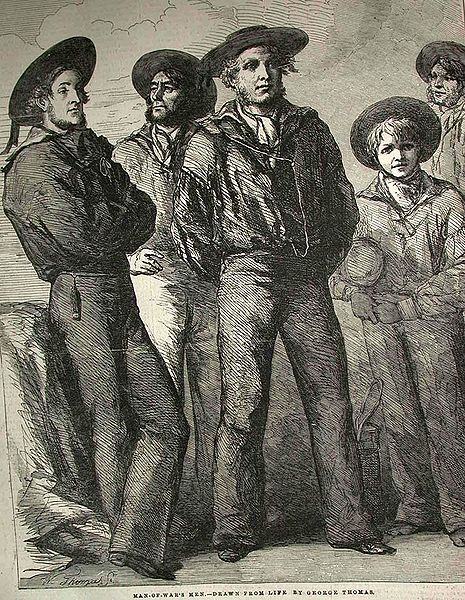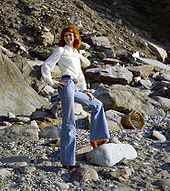| www.FlowJeans.com | www.FlowResearch.com |
Bell Bottom Jeans
Source: Wikipedia.org
| Bell-bottoms
(or flares) were a style of pants
that become wider from the knees
downward, forming a bell-like shape of the pant leg.
Naval Origins In the early 19th century, when a standardized uniform did not yet exist in the U.S Navy, some sailors adopted a style of wide trousers ending in bell-shaped cuffs. In 1813, one of the first recorded descriptions of sailors' uniforms, written by Commodore Stephen Decatur, noted that the men on the frigates United States and Macedonia were wearing "glazed canvas hats with stiff brims, decked with streamers of ribbon, blue jackets buttoned loosely over waistcoats, and blue trousers with bell bottoms." The British Royal Navy had often been a leader in nautical fashion, but bell-bottoms did not become part of their standard uniform until the mid-19th century. These "bell-bottoms" were often just very wide-legged trousers, rather than shaped trousers that flared below the knee. |
Illustration of sailors in uniform, 1854 |
Although the trousers of the current uniform of the United States Navy are still referred to as "bell-bottomed", they simply have large straight legs. The sailor's thigh fills the upper trouser leg, making the bottom of the pants leg appear flared. This style has been popular for many years, perhaps because the trouser leg can be rolled up easily, allowing the sailor to work bare foot, but there is no reliable documentation that confirms a specific timeline or reason for the popularity of bell-bottomed trousers in naval apparel.
60s to early 80s
In the mid-1960s, bell-bottoms became fashionable for both men and women in Europe and North America. Often made of denim, they flared out from the bottom of the calf, and had slightly curved hems and a circumference of 18 inches (46 cm) at the bottom of each leg opening. They were usually worn with Cuban-heeled shoes, clogs, or Chelsea boots. Toni Basil, who was a go-go dancer when the 1964 concert film The T.A.M.I. Show was released, appeared in the film wearing bell-bottoms with a baby doll blouse.
By 1967, bell-bottoms had transitioned from high fashion to part of the hippie counter-culture movement, a style exemplified by love beads, granny glasses, and tie-dye shirts. Bell-bottoms were even mentioned in popular music, such as the single "Bell Bottom Blues" by blues-rock group Derek and the Dominos.
In the 1970s, bell-bottoms moved back into mainstream fashion; Sonny and Cher helped popularize bell-bottoms in the US by wearing them on their popular television show.The pants were typically flared from the knee down, with bottom leg openings of up to twenty-six inches. Made from denim, bright cotton and satin polyester, they were so popular that they became a symbol of the outlandish and colorful style of the decade..
Loon pants (shortened from "balloon pants") were a variant on bell-bottomed trousers, with an increased flare. They were worn occasionally by go-go dancers on the British TV music variety show Ready Steady Go! in 1966.
Elephant bells, popular in the mid-to-late 1970s, were similar to loon pants, but were typically made of denim. Elephant bells had a marked flare below the knee, often covering the wearer's shoes. The preferred shoes were platform shoes with soles at least 2 inches (5.1 cm) thick and heels 4 to 5 inches (10 to 13 cm) to keep the pants' hems off the ground.
Today, original bell-bottoms from the 1960s, 70s, and 80s are collectible vintage clothing.
Late 80s to Mid 00s
In the late 1980s, with the rise of acid house music and the Second Summer of Love period (1988 to 1989 in Great Britain), bell-bottoms became popular again in Europe, spreading to the Americas, South Africa, Japan, and Australia. They were initially reintroduced as boot-cuts, which taper to the knee and loosen around the ankle to accommodate a boot. Over time, the width of the hem grew wider and the term flare-leg was favored over bell-bottom in marketing. Today, both boot-cut and flare-leg pants remain popular both in denim fashion and higher-quality office wear. Initially in Europe, straight leg jeans also gave way to boot-cut looks, and have made the leap into flare-legs for office wear.
Women's boot-cut jeans are tighter at the knee than men's, and flare out from knee to hem, while men's styles are usually flared from crotch to hem. The bell-bottoms of the 1960s, 70s, and 80s can be distinguished from the flare or boot-cut pants of the 90s and 00s by the tightness of the fabric at the knee.
|
What's Your Style? - Low-Rise Jeans - Skinny Jeans - Wide-Legged Jeans - Bell Bottoms |
Sponsored by:
27 Water Street
Wakefield, MA 01880
(781) 245-3200
(781) 224-7552 (fax)
info@flowresearch.com

